Essential Guide to Cleaning and Seasoning Iron Skillets
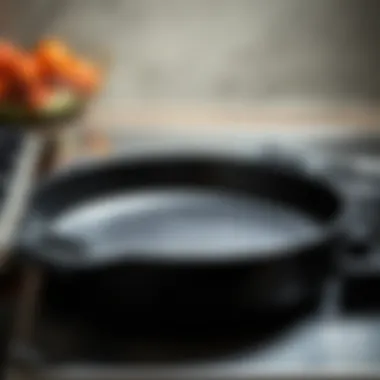
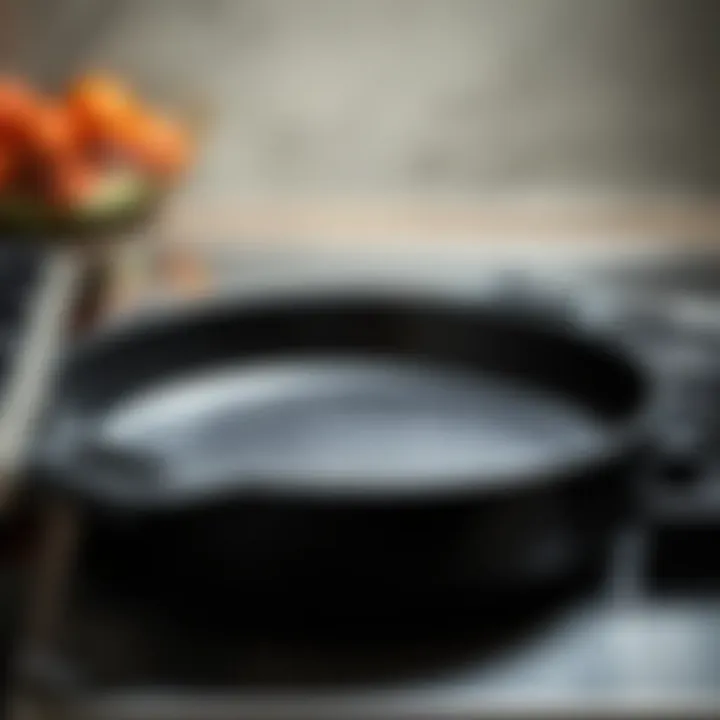
Intro
Understanding how to care for an iron skillet is crucial for anyone who spends time in the kitchen. These skillets are not just tools; they are a culinary investment that can provide years of exceptional service when treated properly. In this guide, we’ll explore how to keep your skillet clean and well-seasoned, allowing it to perform at its best. By delving into the practices of cleaning and seasoning, we will recognize their significance in maintaining the skillet’s longevity and performance.
As we navigate through the steps for optimal care, it’s important to highlight that knowledge about the chemistry of iron cookware plays a role in enriching your cooking experience. We’ll break down various cleaning and seasoning techniques, catering to both novices and seasoned cooks. In the world of cooking, taking the time to understand your tools can lead to remarkable results, and your iron skillet is no exception!
Ingredients Breakdown
To maintain your iron skillet, you’ll need some basic ingredients and tools, albeit not the culinary ones that typically come to mind.
Primary Ingredients
- Natural oils such as flaxseed oil, grapeseed oil, or vegetable oil are essential for seasoning. These create the protective layer that enhances the skillet’s surface over time.
Optional Ingredients
- Salt can be used as an abrasive to aid in cleaning stubborn residue. Consider using kosher salt for a coarser texture.
- Baking soda is also a useful option for deodorizing and tackling tough stains.
Essential Kitchen Tools
- Scrub brush or sponge: Choose one that won't scratch the skillet yet is tough enough to remove bits of food.
- Paper towels or a clean cloth: These help with applying oil and wiping down the skillet.
- A baking sheet: This is useful for catching drips or excess oil during the seasoning process.
- Oven mitts: Always a good idea, they keep your hands safe from hot surfaces.
Step-by-Step Preparation
Cleaning and seasoning your iron skillet is a methodical process that can yield excellent results with a bit of patience.
Prepping the Ingredients
Start by ensuring your skillet is free from food residue. After cooking, it’s advised to let the skillet cool down slightly before cleaning, as drastic temperature changes can lead to warping.
Cleaning Techniques and Methods
- Basic Cleaning: Use warm water and your scrub brush or non-metal sponge to gently scrub the skillet. Avoid soap, as it can strip the seasoning layer. For stubborn bits, consider a pinch of salt as an abrasive.
- Deep Cleaning: If you have a very dirty skillet, baking soda can come in handy. Make a paste with water and scrub the skillet carefully.
Assembly and Presentation Tips
After cleaning, dry the skillet on medium heat on the stove. This ensures all moisture evaporates. Once dry, it’s time for the seasoning process.
Seasoning Your Skillet
Now comes the fun part: seasoning your skillet, which creates that ideal non-stick surface everyone craves. Apply a thin layer of oil all over the skillet, inside and out. Place it upside down in the oven at a high temperature, around 400°F, to allow the oil to bond with the iron.
Common Help Sections and Troubleshooting
"A well-maintained iron skillet can be passed down through generations, making it much more than just a cooking tool."
Frequently Asked Questions
- How often should I season my skillet? It really depends on usage. Once a month is a good starting point, but if you notice food sticking, it may need more frequent treatments.
- What if my skillet rusts? Don’t panic! Simply scrub the rust away, clean the skillet, dry it, and re-season.
Common Mistakes to Avoid
- Using soap during routine cleaning.
- Skipping the drying step before re-seasoning.
Solutions to Potential Problems
If your skillet starts to stick, it’s a clear sign it needs re-seasoning. If the seasoning burns off over time, simply clean and repeat the oil application.
In summary, taking the time to properly clean and season your iron skillet will enhance not only the skillet’s performance but also enrich your cooking experience. Your efforts ensure this timeless tool serves you well for years to come.
Understanding Iron Skillets
Iron skillets stand as a monument to culinary history. There’s more to these heavy-duty pans than meets the eye. Whether you're a seasoned chef or a casual cook, understanding the background, advantages, and drawbacks of using iron skillets can elevate your cooking experience significantly.
History of Iron Cookware
The story of iron cookware traces back several centuries. Nomadic tribes used rudimentary pans made from heated iron hundreds of years ago. In Europe, the craft of ironworking merged with cooking as blacksmiths began forging skillets for kitchens. Fast forward to the 18th century, cast iron skillets, which became widespread, were produced in various designs, addressing the needs of both wealthy and common households. These skillets were not just cooking tools but status symbols, often adorned with intricate designs.
Cooking techniques evolved, and so did the use of iron. During the American Revolution, many households relied on iron skillets for their durability and heat retention. The cast-iron skillet thus became a staple of American cuisine, left to future generations with tales of its robust nature and versatile utility.
Advantages of Using Iron Skillets
Iron skillets boast numerous perks that make them a kitchen essential. Here are a few highlights:
- Heat Retention: Once heated, an iron skillet holds onto that warmth longer than lighter materials, ensuring even cooking without frequent temperature adjustments.
- Versatility: An iron skillet can go from stovetop to oven without missing a beat. You cannot say that about every pan!
- Natural Non-Stick: With proper seasoning, an iron skillet develops a natural non-stick surface, making it ideal for cooking everything from eggs to steaks without sticking.
- Health Benefits: Cooking with iron can help increase dietary iron intake, especially beneficial for those who may be deficient.
These benefits underscore why iron skillets have remained a beloved tool in kitchens worldwide.
Disadvantages of Iron Skillets
However, iron skillets are not without their challenges. Understanding these can prepare you for potential pitfalls:
- Weight: They can be cumbersome and heavy, particularly when filled with food, making them tough for some to handle.
- Care: Proper maintenance is crucial to prevent rust and ensure longevity. This involves cleaning and seasoning, which can be a bit more demanding than simply tossing a non-stick pan in the dishwasher.
- Reactivity: Acidic foods like tomatoes can interact negatively with unseasoned cast iron, resulting in a metallic taste and discoloration of the skillet.
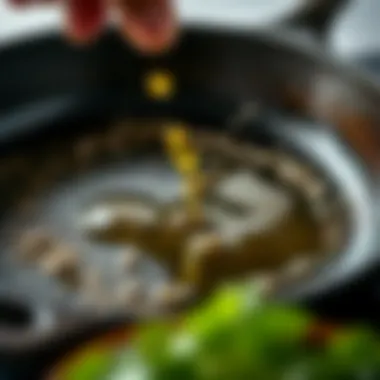
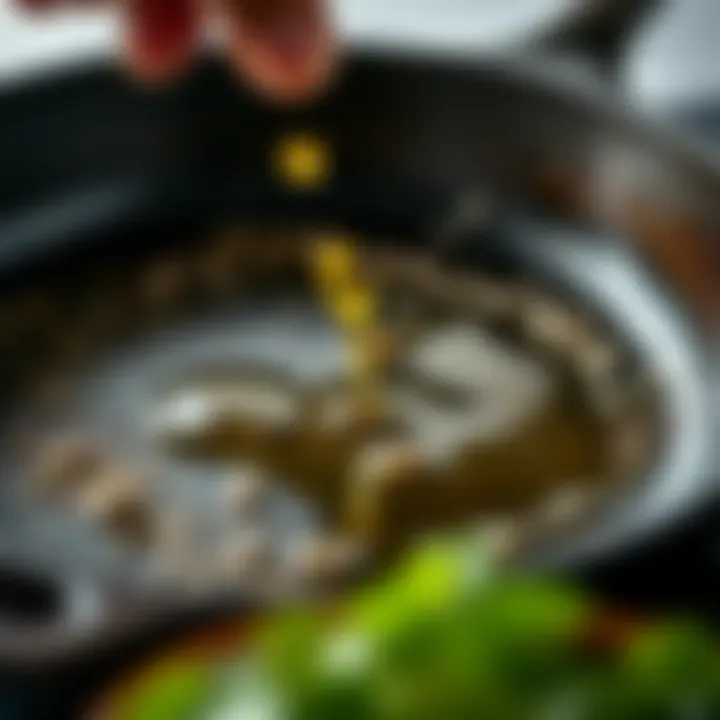
An iron skillet offers many upsides, but being mindful of its drawbacks can save you from a world of headaches.
Understanding these elements gives you insights into making the most of your iron skillet, ensuring that it not only serves its purpose in cooking but also stands the test of time.
The Importance of Cleaning
Cleaning your iron skillet is not just a chore but a cornerstone of effective cooking. Understanding the significance behind this practice can transform your culinary experience. It's about maintaining the skillet’s integrity and ensuring that each meal, from a simple scrambled egg to a roast, is prepared in an environment that supports flavor and health.
A clean skillet restores the essence of the food. Residues from previous meals can interfere with taste and even alter cooking results. For instance, leftover oils can smoke and impart an off-flavor to the dish being prepared. By cleaning your skillet properly, you set the stage for success in your kitchen endeavors. This practice also makes the skillet more enjoyable to use, allowing you to cook with confidence.
Beyond flavor, cleaning is essential for health reasons too. Properly maintained cookware minimizes the risk of foodborne illnesses. Bacteria thrive in remnants of food, and skipping cleaning can lead to unwanted surprises on your plate.
"An iron skillet is like a loyal friend; treat it well, and it will serve you for years to come."
The time and effort invested in cleaning pay dividends in the long run. An iron skillet that is regularly cleaned and cared for can last generations, becoming a family heirloom rich with stories and flavor. Furthermore, a clean skillet is much easier to season, preserving its non-stick quality.
In sum, regular cleaning is not merely about hygiene, but it’s integral to maximizing the performance and lifespan of your beloved cookware. It's a ritual that, when embraced, enhances both your cooking and your appreciation for the art of gastronomy.
Why Cleaning Matters
Cleaning an iron skillet is paramount to its function. Without a proper scrub down, the skillet's surface can accumulate debris, which may lead to flaking seasoning or rust. By taking the time to clean, you ensure that the seasoning remains intact and effective, providing both non-stick properties and a barrier against moisture.
Cleaning is more than removing food particles; it's about preserving the cookware's character. Each wash replenishes the surface, empowering it for future culinary challenges. When the skillet is cleaned and dried properly, it becomes a blank canvas, ready for the next culinary masterpiece.
Common Cleaning Myths
Despite the widespread usage of iron skillets, various myths persist regarding their cleaning. One of the prominent misconceptions is that soap will ruin the seasoning. While it is prudent to limit soap use, especially on well-seasoned skillets, a small amount can help remove stubborn grease effectively. Use it sparingly; the key is to rinse it thoroughly afterward.
Another myth suggests that they should never be submerged in water. While it's best to avoid soaking, a quick rinse is fine. What’s more important is the drying process. Make sure to thoroughly dry the skillet after cleaning to prevent rusting.
Here’s a look at some common cleaning myths:
- Myth 1: Soap ruins seasoning.
Truth: A light use of soap won’t strip seasoning completely. - Myth 2: Iron skillets can't be soaked in water. Truth: A brief soak is acceptable, but avoid prolonged exposure.
- Myth 3: Scrubbing will damage the skillet. Truth: Using the right tools like a stiff brush can enhance its longevity.
By debunking these myths, you can uphold best practices for cleaning, keeping your skillet in prime condition and ensuring it remains a trusted kitchen companion.
Pre-Cleaning Preparations
Before diving into the nitty-gritty of cleaning your iron skillet, it’s essential to pause and prepare adequately. Pre-cleaning preparations may seem like an inconvenience at first. Yet, they play a crucial role in ensuring that the cleaning process is efficient and thorough.
First up, collecting your supplies is paramount. It not only adds to the convenience but also helps in addressing any specific cleaning needs of your skillet without scrambling at the last minute. Having the right tools on hand makes the task feel less overwhelming. Think of it like gathering your literary devices before composing a powerful essay; each tool contributes to your overall success.
Secondly, assessing the skillet's condition is a critical step that cannot be overlooked. Understanding the state of your skillet will inform your cleaning approach. Isn’t it akin to reading a novel and understanding the character’s backstory before diving into the plot? It gives depth to your actions and shapes the subsequent steps you’re going to take.
Gather Your Supplies
When preparing to clean your iron skillet, the supplies you gather can make or break the process. You want to think strategically about what you'll need, focusing on two primary categories: cleaning tools and protective items.
- Cleaning tools:
- Protective items:
- A stiff brush: A basic but effective tool, it helps remove built-up food residues.
- Soft cloths or paper towels: These are perfect for wiping surfaces and applying oil during the seasoning process.
- Coarse salt: A natural abrasive that can effectively scour away stubborn bits.
- Baking soda: This versatile ingredient can be a handy solution for oily residues.
- Vinegar: Great for breaking down tough stains or rust.
- Gloves: Depending on your preferences, these can keep your hands clean and safe while working with harsh cleaners.
- An apron: A simple safeguard for your clothing; after all, cooking can get messy!
Before you even think about starting, take a moment to ensure you have everything set out before you. This simple act can prevent interruptions and frustrations down the line.
Assessing the Skillet's Condition
Once you’ve gathered your supplies, take a good look at your skillet. This is not just about giving it a casual glance; it involves a careful assessment that helps guide your cleaning techniques.
- Look for signs of wear and tear:
- Consider past usage:
- Is there visible rust?
- Are there scratches or chipping?
- How does the seasoning appear—flaky, or is it still smooth and well-maintained?
- Has your skillet been in regular use, or has it spent more time at the back of the cupboard?
- Perhaps it’s seen some heavy-duty frying sessions?
These observations will determine the amount of effort needed in cleaning. For instance, if you spot extensive rust, you might need more time and a stronger method to deal with it compared to a lightly used skillet.
Preparing adequately before you start cleaning your iron skillet sets the stage. It brings clarity to your actions and transforms what could be a mundane task into a thoughtful ritual. In the world of culinary arts, every step matters, and pre-cleaning preparations give you the advantage to start strong.
Methods for Cleaning an Iron Skillet
Cleaning an iron skillet isn’t merely about removing food residue; it’s a critical practice that impacts both the longevity of the skillet and the quality of your cooking. A well-maintained skillet offers a surface that promotes even heating and a naturally non-stick experience when properly seasoned. In this section, we'll explore effective cleaning methods, catering to different circumstances, from basic techniques to more challenging scenarios involving stubborn grease and rust. Understanding these methods can be the difference between a skillet that's a pleasure to use and one that becomes a chore to maintain.
Basic Cleaning Techniques
When it comes to basic cleaning, simplicity is key. After using your skillet, while it's still warm but not too hot to handle, scrape off any food particles with a spatula or a stiff brush. It’s important not to use soap as it can strip away the seasoning. Instead, rinse the skillet under hot water. If necessary, you can use a plant-based scrubber or coarse salt as an abrasive to lift stubborn bits without damaging the seasoning. Here’s a step-by-step approach to cleaning:
- Let the skillet cool slightly: Avoid washing a hot skillet with cold water to prevent warping.
- Scrape off food debris: Use a spatula or a wooden spoon.
- Rinse with hot water: Tundering water helps to remove grease and residual food.
- Dry immediately: Use a towel to wipe it down, ensuring it's completely dry to prevent rusting.
- Light oiling: After cleaning, rub a small amount of oil on the surface to maintain the seasoning.
By following these simple steps, you maintain your skillet’s integrity, ensuring it’s ready for the next culinary adventure.
Dealing with Stubborn Grease
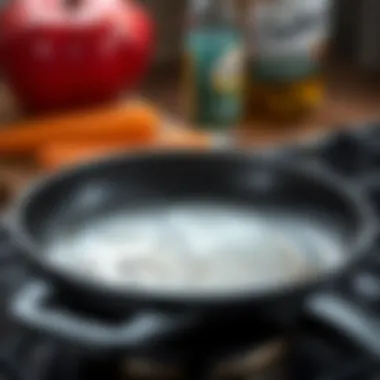
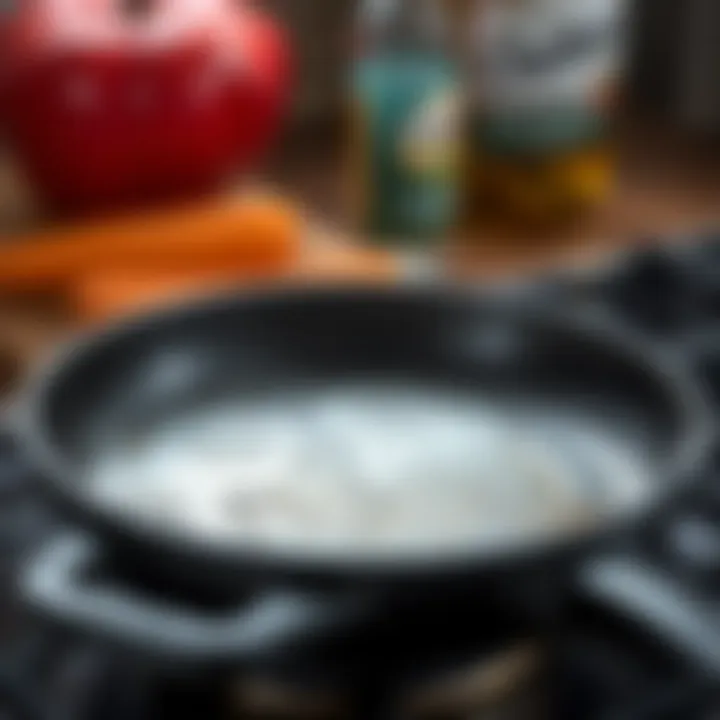
Sometimes, you may face the unfortunate fate of stubborn grease clinging to your skillet like an unwelcome guest. When this happens, the basic cleaning approach might not cut it. Luckily, there are techniques to tackle this residue without compromising your skillet’s beloved seasoning.
- Use heat: Place the skillet on the stove over medium heat. Let it warm up, which often helps loosen the grease.
- Coarse salt scrub: Sprinkle a generous amount of coarse salt while the skillet is still warm. With a damp cloth or a sponge, scrub the surface. The grit of the salt acts as a natural abrasive.
- Baking soda paste: For a more stubborn layer, create a paste of baking soda and water. Apply it to the greasy area and let it sit for a few minutes before scrubbing it off with a sponge. Rinse well afterward.
Blockquote:
"Maintaining cleanliness in your iron skillet is not just for aesthetics; it enhances its life and performance in your kitchen."
This proactive stance not only eliminates the grease but leaves your skillet shining and ready for action.
Removing Rust
Rust is the enemy of iron skillets, but fret not. If you spot it, swift action can salvage the skillet. Here’s how to effectively remove rust:
- Assess the extent of rust: If it’s just surface rust, a good scrub might suffice. If it’s deeper, you might need to employ more rigorous methods.
- Use steel wool or fine-grit sandpaper: For any significant rust, gently scrub the affected areas. Be cautious, as you don't want to scrape off the seasoning too aggressively.
- Create a vinegar soak: If the rust is stubborn, immerse the skillet in a mixture of equal parts water and white vinegar for a few hours. This acidic solution helps to dissolve the rust.
- Rinse and re-season: Once the rust is removed, wash the skillet, dry it thoroughly, and proceed with re-seasoning to restore its protective coating.
By treating rust promptly and effectively, you bring your skillet back to life, ready for whatever culinary delights await.
Drying and Storing Your Skillet
Caring for your iron skillet doesn’t end with cleaning and seasoning. The drying and storing processes are equally pivotal, ensuring that your skillet maintains its functionality and longevity in your kitchen repertoire. A well-dried skillet sets the stage for proper seasoning and maintains the integrity of the skillet, while improper storage can inadvertently lead to rust and a decline in performance. Let’s dive into the specifics.
Proper Drying Techniques
Once you've finished cleaning your iron skillet, it’s crucial to dry it thoroughly. Leaving any moisture can create a breeding ground for rust, which can damage the skillet's surface.
To effectively dry your skillet:
- Immediate Drying: Right after rinsing, dry the skillet with a clean cloth or paper towel. Cling to that habit; haste makes waste!
- Use Heat: After patting it down, place the skillet on low heat on the stovetop for a few minutes. This will help evaporate any residual moisture. You’ll notice it starts to feel warm and dry instead of damp.
- Oil Application: Applying a thin layer of your chosen cooking oil after drying can also prevent moisture from settling back in. This simple act fortifies the seasoning layer while securely sealing the surface. Just don’t overdo it—too much oil is like too much of a good thing; it can lead to a sticky mess.
By following these drying techniques, not only do you protect your skillet from rust, but you also keep it in pristine condition for your next culinary adventure.
Storage Considerations
Proper storage of your iron skillet is like putting a seed in fertile soil; it helps ensure a rich return in usability and longevity. Here are a few practical considerations to help you store your skillet wisely:
- Cool Down: Always ensure your skillet is completely cool before putting it away. Storing it while still warm can trap moisture and lead to that dreaded rust problem.
- Avoid stacking: If you have multiple skillets or any other cookware, avoid stacking them directly on top of each other. Use a cloth or paper towel to separate them. This little barrier can prevent scratches on the seasoned surface.
- Choose the Right Spot: Store your skillet in a dry place, away from humid areas like dishwashers or sinks. Place it in a cabinet or on a shelf where it's not exposed to moisture.
- Lid or Not? Some cooks prefer to cover their skillets with a lid; this has its merits as it prevents dust from settling in. However, if you choose to do this, ensure that the skillet is completely dry and cool first to stave off any moisture mistakes.
Remember: Proper storage is as important as cleaning and seasoning. A well-stored skillet can last a lifetime and serve as a family heirloom.
Taking these aspects into account will help you cherish your iron skillet for years to come, continuously delivering wonderful meals that are grilled, seared, or baked to perfection.
The Process of Seasoning
The process of seasoning an iron skillet is more than just a routine task; it is an essential rite of passage that transforms your raw iron cookware into a reliable kitchen companion. Seasoning gives the skillet a non-stick surface while offering a barrier against rust. This ritual is particularly vital when considering the longevity of your skillet, as it not only enhances performance but also protects the integrity of the material.
As you dive into the art of seasoning, it’s critical to understand how this process interacts with the iron. When heated, the oils you apply undergo a chemical transformation, polymerizing to create a hardened layer that bonds with the iron surface. Essentially, we're talking about a fine alchemy of heat and oil that builds the character of your skillet over time.
Why Seasoning is Essential
The importance of seasoning cannot be overstated. Imagine cooking a perfect steak; you want that mouthwatering, golden-brown crust without the meat sticking to the pan, right? Seasoning downplays the stickiness and enhances flavor as well.
Moreover, when you effectively season your skillet, you’re creating an environment that wards off unwanted elements like rust. Raw cast iron has a propensity to oxidize when exposed to moisture—think of it, if you will, as a struggle between iron and time. Seasoning forms a shield, ensuring your skillet maintains its beautiful functionality through thick and thin.
To put it simply:
- Non-stick properties: Prevents food from adhering to the surface.
- Rust prevention: Protects from moisture and environmental factors.
- Flavor enhancer: Adds depth to your dishes by improving how they cook.
"An iron skillet seasoned well is like a man's best friend in the kitchen—loyal and endlessly resourceful."
Selecting the Right Oils for Seasoning
When it comes to choosing oils for seasoning, not all oils are created equal. You'll want to select high-smoke point oils, as they can endure the higher temperatures required during the seasoning process. Here are some of the most popular options:
- Flaxseed oil: Renowned for its ability to create a hard, long-lasting seasoning, making it a popular pick.
- Grapeseed oil: Offers a neutral flavor and handles heat well.
- Canola oil: Easy to find and effective for seasoning, though some may argue it doesn't form quite the same depth as flaxseed.
- Vegetable oil: A versatile choice that many cooks have in their pantry.
Here’s a simple guide to choosing:
- High smoke point: Aim for oils that won’t break down easily.
- Availability: Pick oils that are easily accessible for you.
- Flavor: Consider how the oil might impact the taste of your food over time.
Step-by-Step Seasoning Process
Seasoning your iron skillet is not just a matter of aesthetics; it's a fundamental practice that directly impacts the performance of your cookware. When done right, seasoning creates a natural non-stick surface that enhances the flavors of your dishes and bolsters the skillet’s resistance to rust. A well-seasoned skillet can become your culinary best friend, transforming simple meals into gastronomic delights. It’s about building a protective layer that not only preserves the iron from moisture but also infuses your cooking with a richness that’s hard to replicate.
Initial Preparation
Before diving headfirst into the seasoning process, it’s crucial to set the stage. First off, make sure your skillet is impeccably clean. If it’s new or has been stripped of its seasoning, give it a nice wash with hot, soapy water and a stiff brush. This step might seem trivial, but starting with a clean canvas is essential. After cleaning, dry your skillet thoroughly. You can simply air-dry it, but placing it on low heat for a few minutes is an effective way to ensure all moisture evaporates.
Gather your materials, which include:
- Oil (flaxseed oil, grapeseed oil, or canola oil are popular choices)
- A paper towel or lint-free cloth for application
- An oven (to bake the skillet)
Once everything is in place, you can kick off the seasoning adventure with confidence.
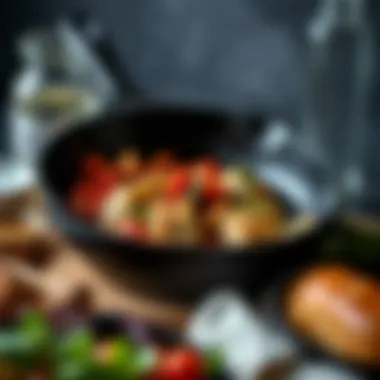
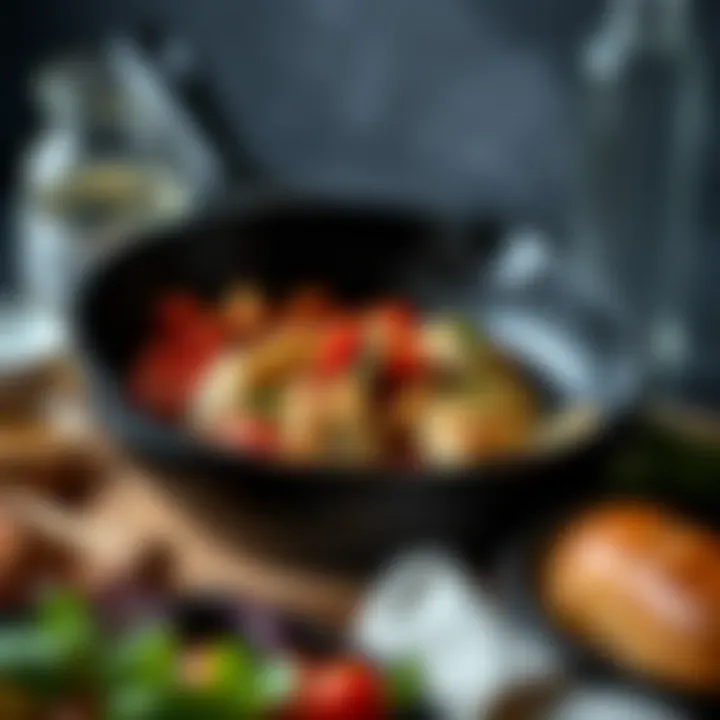
Applying Oil
Now comes the fun part—applying the oil. Take your chosen oil and pour a small amount onto the skillet, usually around one tablespoon or so. Use the paper towel or cloth to spread it evenly across the entire surface. Don’t forget the sides! You want to coat the skillet thinly, as a heavy application may lead to a sticky finish. Too much oil can trap moisture and create a less than ideal surface. A thin layer allows for better adhesion and a smoother finish.
It's important to not rush this step. A well-distributed layer of oil will make all the difference in how your skillet performs in the long run.
Heating the Skillet
Once you've applied oil, it's time to heat the skillet. Preheat your oven to about 450°F (232°C). Once at temperature, place the skillet upside down on the oven's top rack. You can place a sheet of aluminum foil on the bottom rack to catch any dripping oil. The heat facilitates the polymerization process—this is where the oil transforms into a hard, protective layer that adheres to the skillet’s surface.
Let it bake for at least an hour. After that, turn off the oven and let the skillet cool down naturally inside. This gradual cooling helps further strengthen the seasoning bond, ensuring longevity and performance.
Cooling and Wiping
After cooling, take the skillet out of the oven. It’s essential to remember that patience is key. Allow it to rest until it's safe to touch. Now came the final stage of this seasoning ritual. Use a clean paper towel to carefully wipe down the skillet again, removing excess oil. This step is paramount; it ensures you won’t have any greasy spots that could lead to rancid flavors in your food.
At this point, you might notice the surface looking glossy and dark—a sign of a promising seasoning job. Your skillet is now ready to take on its culinary tasks, from frying up a batch of crispy potatoes to searing a steak to perfection.
"Proper seasoning elevates an iron skillet from just a cooking tool to a treasured kitchen companion."
In sum, the step-by-step seasoning process plays a vital role in enhancing the functionality and longevity of your iron skillet. When well-maintained, it offers a fantastic cooking experience that wears well over time. So, embrace the seasoning process, as it sets the foundation for a lifetime of delicious meals.
Maintenance of Seasoning
Maintaining the seasoning on your iron skillet is crucial for ensuring it performs at its best. When cared for properly, the seasoning creates a non-stick surface while preventing the skillet from rusting and degrading. It’s like a well-tuned musical instrument; if you neglect it, the harmony is off and you won't get the desired results in the kitchen. This section digs into the specifics of maintaining the seasoning of your skillet—what to look out for and the best practices to adopt.
Recognizing When to Re-Season
Understanding when your skillet needs a re-season is essential to extending its life and optimizing cooking performance. There are several indicators:
- Visual Signs: If you start seeing patches of dull, metallic surface or flakiness, it’s a tip-off that the seasoning is wearing thin.
- Food Sticking: If your eggs or pancakes start sticking like they’re having a meltdown, it’s high time to give your skillet some love and re-season it.
- Rust Appearance: Note any rusting as a clear sign your seasoning is inadequate. This means moisture penetrated where it shouldn’t have.
In practical terms, re-seasoning every few months, or after heavy use, is often necessary. Pay attention to these hints; they resemble the warning lights on your vehicle's dashboard—ignore them and you might be left stranded.
Routine Maintenance Practices
Maintaining the seasoning doesn’t need to be a Herculean task. Engaging in simple daily habits can make a huge difference:
- Gentle Cleaning: After cooking, avoid harsh soaps or scrubbing pads. Warm water and a soft cloth will do the trick. If there's residue, consider using a non-metal brush.
- Dry Thoroughly: Always ensure your skillet is completely dry before storing it. Leaving it moist can introduce rust. A good trick is to place it on low heat for a few minutes to eliminate any water.
- Apply Oil Wisely: After drying, applying a thin layer of oil helps maintain the seasoning. Use oils like flaxseed or grapeseed, which have higher smoke points, ensuring the layer is both protective and effective.
"A well-maintained iron skillet is not just a cooking tool; it’s an investment in your culinary journey."
- Regular Use: Using your skillet frequently helps keep the seasoning in good shape. The oils from the food contribute to building and sustaining the seasoning layer; it’s a co-dependent relationship.
In summary, recognizing when to re-season and implementing routine maintenance practices can significantly prolong the life of your iron skillet. Give it the attention it deserves, and it'll reward you with delicious meals for years to come. Don’t ignore the basics—focus on them to keep your culinary adventures unblemished and enjoyable.
Troubleshooting Common Issues
When it comes to iron skillets, even the most seasoned cooks can encounter a handful of issues. The art of troubleshooting is vital. This segment discusses why addressing problems early is essential to avoid a skewed cooking experience and maintain the integrity of your beloved skillet. Regular maintenance and attention can greatly steer you clear of mishaps that might otherwise ruin your culinary exploits. It’s about fostering a relationship with your cookware, ensuring it remains your trusty partner in the kitchen.
Identifying Seasoning Problems
Recognizing seasoning problems before they spiral out of control can save you a lot of hassle down the line. There are several telltale signs that your skillet’s seasoning may not be up to snuff. Let’s lay them out:
- Discoloration: If your skillet starts to exhibit dull, gray, or uneven patches, it might indicate that the seasoning isn’t functioning properly.
- Food Sticking: Perhaps the most frustrating of issues. If your fried eggs or pancakes seem to adhere more than usual, your skillet’s protective layer may be wearing thin.
- Rust Formation: The bronze color of iron is beautiful, but any reddish-brown speckles suggest rust, a surefire indication that you need to refresh your seasoning process.
- Off Smells: When heating the skillet, if you notice unpleasant or rancid odors, something’s gone awry with the seasoning process and needs correction.
These indicators act as your guiding compass in the journey of maintaining your iron skillet. By catching these problems early, you can avoid further deterioration and costly fixes.
Solutions for Common Problems
Now that you've spotted some issues, here’s how to tackle them head-on. Each problem has its remedy, allowing you to revitalize your skillet and get back to cooking without a hitch.
- Addressing Discoloration: If you find your skillet has lost its luster, applying a fresh layer of seasoning often does the trick. Clean the skillet thoroughly, remove any rust, and follow the seasoning process outlined earlier. Be patient; good things come to those who wait.
- Resolving Food Sticking: If your food's sticking like glue, it may be time to reevaluate your cooking oils. Ensure that you’re using the right oil with a high smoke point, such as canola or grapeseed oil, during the seasoning process. Also, consider reseasoning the skillet to rebuild that non-stick surface.
- Eradicate Rust: For spots of rust, it's necessary to scrub them away gently with steel wool. Once the rust is gone, wash with soap (yes, this is allowed in this case), dry it thoroughly, and re-season the skillet immediately to restore its strength.
- Neutralizing Off Smells: If your skillet emits unwanted odors, it's best to cleanse it and examine the oil used for seasoning. Using a rancid oil might lead to lingering smells. Use fresh, neutral oils to remove any previous, problematic layers.
Important Note: Routine checks and attention to these potential problems will greatly enhance the longevity of your skillet.
The End
Caring for your iron skillet is not just a chore; it's an art. When we talk about cleaning and seasoning, we're not just discussing maintenance but also the essence of cooking with iron. An iron skillet, with its unparalleled heat retention and distribution, becomes more than a mere cooking tool. It evolves into a beloved companion in the kitchen, reminiscent of family recipes passed down through generations.
The heart of this article is to emphasize that proper care extends the life of your skillet and enhances its cooking capabilities. When a skillet is well-seasoned, it provides a natural non-stick surface, which means you can cook with less oil, allowing the ingredients to shine.
Taking the time to regularly clean your skillet after each use, recognize the signs for re-seasoning, and troubleshoot minor issues contributes to a cooking experience that can bring you joy. Moreover, investing in knowledge about your cookware's needs demonstrates an appreciation for craftsmanship, not just convenience. You’re not merely maintaining a kitchen tool; you are nurturing a piece of culinary history perfectly tailored to your taste.
"A well-cared-for skillet is not just cookware; it's a canvas for culinary art."
Moreover, let's not overlook the consideration of health. A properly seasoned pan can PREVENT rust and harmful reactions with food. Iron cookware, if well-maintained, can add trace amounts of iron back into your diet, beneficial for many.
As you put into practice the insights gleaned from this guide, you will find a relationship with your skillet that deepens over time. Each meal cooked in it comes with a rich backstory that enhances the flavor of your creations. So, whether you are a novice or a seasoned chef, the wisdom you gain about cleaning and seasoning will elevate your culinary adventures and sustain your trusty iron skillet for many years ahead.
Final Thoughts on Caring for Your Iron Skillet
Looking ahead, caring for your skillet is a lifelong commitment that pays dividends. It may seem laborious at times, especially when busy life takes over, but the magic of cooking with a well-maintained skillet is irreplaceable.
To recap:
- Understanding Your Skillet: The metal itself requires different handling compared to other cookware.
- Routine Checks: Regularly examining the seasoning and ensuring it's properly maintained can save a lot of trouble later on.
- Embrace the Process: Celebrate the quirks of your skillet. Each nick and mark tells a tale of meals shared and experiences had.
As you navigate through your culinary journey, consider your iron skillet a valued partner. Cherish it, learn from it, and let it age gracefully alongside your culinary skills. Remember, a well-loved skillet is an investment in both your cooking and your overall health. Over time, your skillet will do more than serve meals; it will serve memories.







